6 Yoga Poses For PCOD: Beat Hormonal Imbalances By Doing These Every Day
5 minuteRead
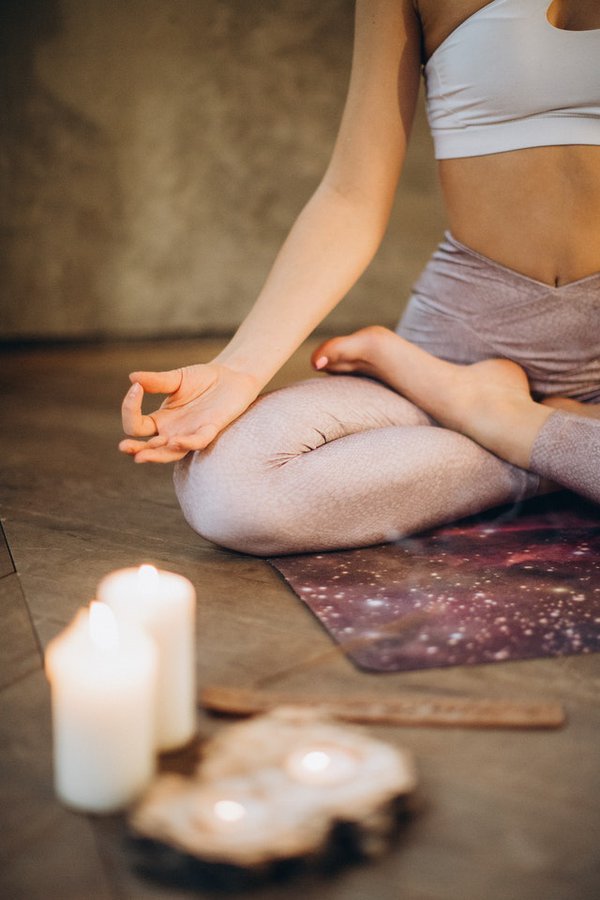
Whether you need to lose a few kilos, are having trouble sleeping, or even need a pick-me-up after a long day - you can turn to yoga to help you through it. So it isn’t surprising that it also makes for an excellent addition to the routine of anyone suffering from Polycystic Ovarian Disorder (PCOD). Multiple studies have found that doing yoga for an hour, even just 3 times a week can lower testosterone levels, which are otherwise quite high due to PCOD.
Yoga practice has also been found to ease the anxiety and depression that the disorder causes while helping with weight management and boosting fitness levels. That sounds like an absolute win in our books! While any form of physical activity is recommended to balance out hormones, when it comes to PCOD yoga poses of a certain kind can prove to be especially beneficial. However, with the pandemic where it is and the price of classes being a bit rough on the wallet, if you’d like to try yoga for PCOD but would prefer starting things off at home, we’ve listed out all the asanas that have been found to be the most beneficial down below.
1. Bridge Pose (Setu Bandhasana)
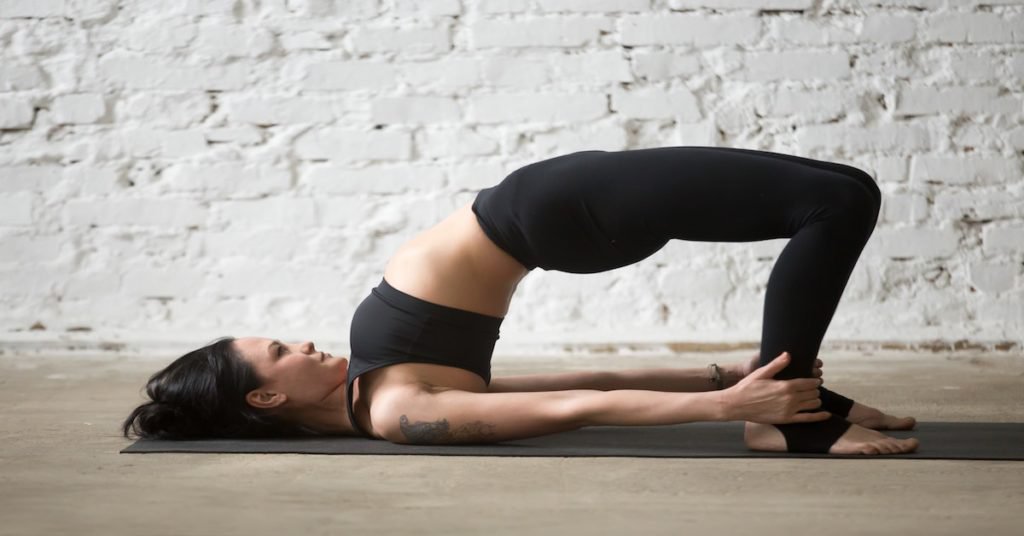
Source- https://www.rishikeshyogisyogshala.org/setu-bandhasana-pose-steps-and-benefits/
This pose stretches out and eases tension in the spine, legs, neck, and chest while also stimulating the abdominal organs, lungs, and thyroid. If you’re down with cramps, which is often a gift that PCOS leaves behind, this pose comes highly recommended. Here’s how you go about performing it.
- Start by lying on your back with your knees folded and feet hip-distance apart, laid flat on the floor.
- Bend your knees and place your hands by your side.
- As you inhale, slowly lift yourself off the floor, starting with your lower back, then mid-back, then upper back.
- As the pelvis lifts up, feel the stretch from the pelvis to sternum.
- Gently roll the shoulders, press your arms and shoulders on the ground, lengthen your tailbone and lift your chest.
- Keep your thighs parallel to each other.
- Breathe with ease and stay in this pose for 1–2 minutes before slowly lowering yourself back onto the ground.
- Repeat up to 5 times.
2. Cat-Cow Pose (Chakravakasana)
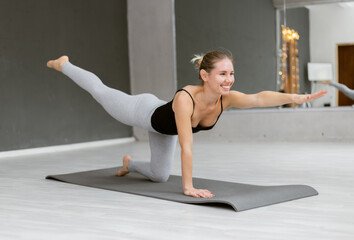
Source- https://stock.adobe.com/ee/search/images?k=chakravakasana&asset_id=391534915
This pose stretches and strengthens the spine, neck, hips, and abdomen while stimulating the kidneys and adrenal glands. In doing so, it promotes emotional balance and relieves stress. This one goes at the top of most lists of PCOS-friendly yoga asanas. Here’s how you can perform it.
- Get in a tabletop position, with your palms facing down on the floor, wrists, and elbows aligned directly under the shoulders, knees under your hips, and ankles straight back from the knees.
- Curl your toes under your feet and inhale.
- Bend your elbows, lower your belly, and lift your chin and tailbone simultaneously.
- Exhale and reverse the movement by tucking the tailbone and chin, and creating a dome with your back as you draw your navel toward the spine as the tip of your chin toward the chest.
- Repeat up to 8 times.
3. Camel Pose (Ustrasana)
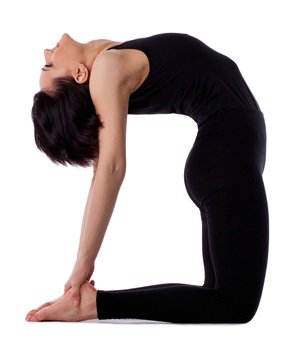
Source- https://www.yogaasan.com/ustrasana-camel-pose/
This pose stretches and strengthens the shoulders, back, chest, and hips while stimulating the abdominal region. It improves digestion, posture, and respiration. This is another great option for when you’re menstruating because it relieves lower back pain.
- Kneel on the ground with your legs at the back, shoulder-width apart, with the heels facing the ceiling.
- As you inhale, draw your tailbone forward and bend back to form an arch.
- Place your palms on your feet for support and keep your elbows straight in order to take the pressure off of your neck.
- Hold this pose for a few seconds and exhale as you lift your hands off of your feet and return to the starting position.
- Repeat up to 5 times.
4. Butterfly Pose (Supta Baddhakonasana)
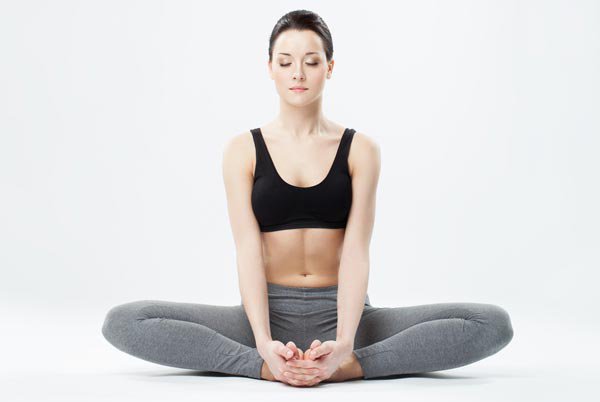
This pose supports the spine and back, hips, inner thighs, chest, shoulders, and knees. It opens up the heart and improves posture while easing bloating and stimulating the abdominal organs, ovaries, and bladder. Not only does this make it great for PCOS but its simplicity makes it ideal for beginners.
- While seated on the mat, extend your legs in front of you.
- Bend your knees and bring your heels toward you as you press the soles together. Your knees will naturally drop to the sides.
- Hold your feet with your hands and take deep breaths in and out as you flap your legs up and down.
- Continue for a few minutes.
- To increase difficulty or prolong the asana, slowly lean back until your back is on the floor. Stretch your arms over your head, palms facing up.
- Close your eyes, breathe deeply for 5 minutes.
- Come out of the pose slowly, by rolling to your right and pausing there while slowly sitting up.
- Repeat up to 4 times.
5. Locust Pose (Shalabhasana)
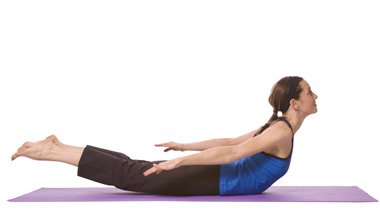
Source- https://www.yogaasan.com/salambhasana-shalabasana-locust-pose/
This pose strengthens the spine, buttocks, and the backs of the arms and legs while stretching out the shoulders, chest, belly, and thighs. It stimulates the abdominal organs, improves posture, and relieves stress. Here’s how you can go about performing it.
- Lie on your belly with your arms by your side and forehead resting on the floor. Gently let the tips of your big toes touch.
- As you exhale, lift your head, then your upper torso, arms, and legs off the floor, in that order.
- Balance yourself on your lower ribs, belly, and pelvis. Raise your arms until they’re parallel to the floor and feel the stretch in your back and you look forward.
- Hold this pose for a few seconds and then slowly release it, starting with your feet and working your way up to the head.
- Repeat up to 5 times.
6. Bow Pose (Dhanurasana)
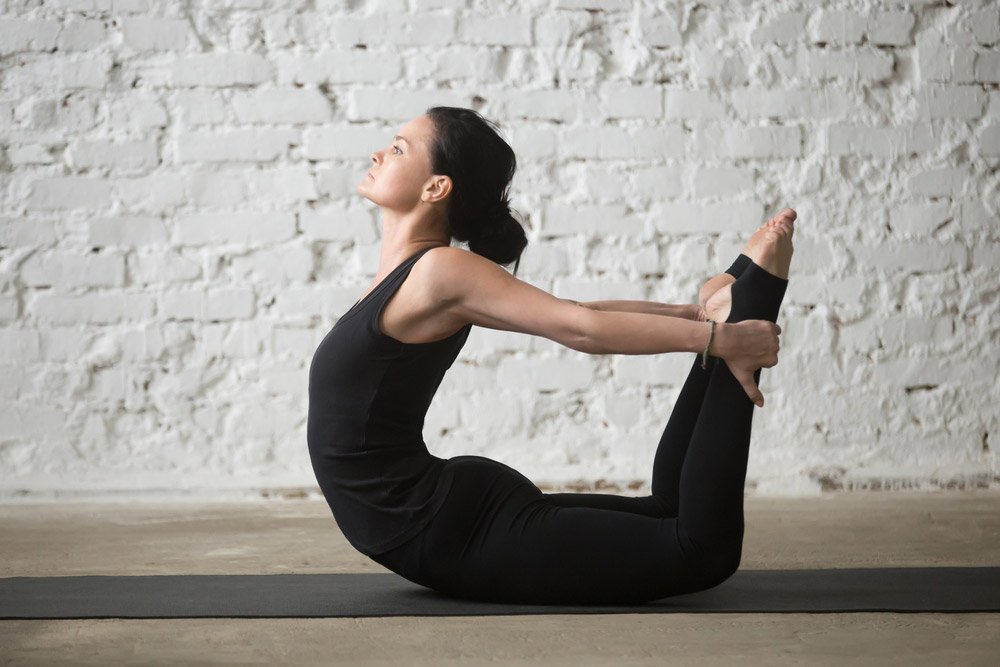
Source- https://lessons.com/yoga-classes/yoga-poses/bow-pose
This pose stretches the neck, shoulders, and legs while stimulating the reproductive organs, increasing circulation to the pelvic region, regulating menstrual flow, and easing stress and anxiety. This makes it a stellar pose for regulating PCOS. Here’s how you can go about it.
- Lie on your stomach with your arms by your side.
- Fold your knees up and reach behind your back to hold your ankles.
- Inhale and lift your chest off of the floor while pulling your legs up by the ankles.
- Hold this pose for a few seconds while breathing steadily.
- On an exhale, release slowly by bringing your chest and legs back towards the ground and then releasing the hold on your ankles to lie face down.
- Repeat up to 3 times.
If you can’t reach your ankles, try doing it one leg at a time or use a yoga strap for ease of access.
While these yoga asanas will certainly help ease the symptoms of PCOD, don’t forget to eat right and take whatever medication you’ve been recommended. And don’t forget, there’s a significant portion of women in their childbearing years who are fighting this disorder right by your side. You’re not alone in this.
Write, Record and Answer! Consume Unlimited Content! All you need to do is sign in and its absolutely free!
Continue with one click!!By signing up, you agree to our Terms and Conditions and Privacy Policy.










